外研版英语七年级下Module 1 Unit 1 Whose bag is this?课件(共41张PPT)
文档属性
| 名称 | 外研版英语七年级下Module 1 Unit 1 Whose bag is this?课件(共41张PPT) | 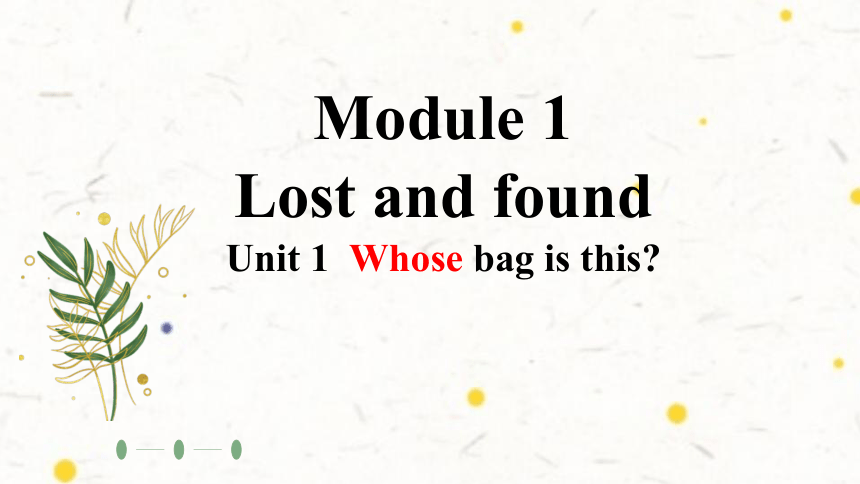 | |
| 格式 | zip | ||
| 文件大小 | 21.2MB | ||
| 资源类型 | 教案 | ||
| 版本资源 | 外研版 | ||
| 科目 | 英语 | ||
| 更新时间 | 2022-02-17 13:14:17 | ||
图片预览

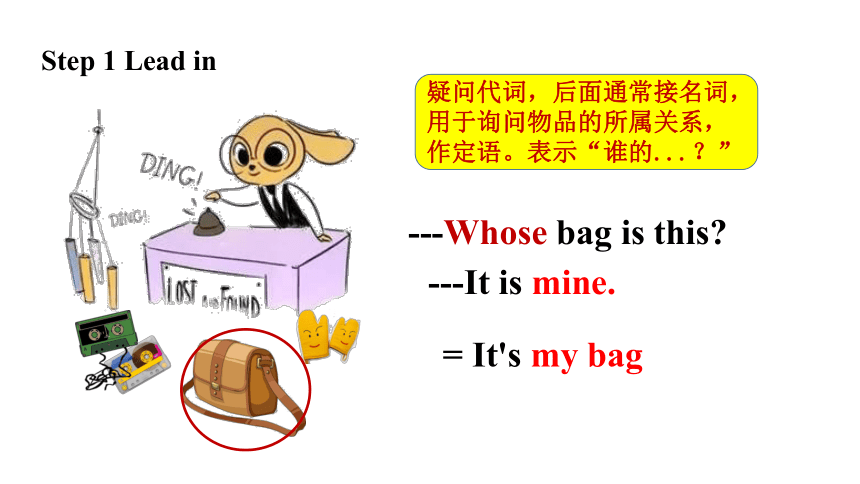
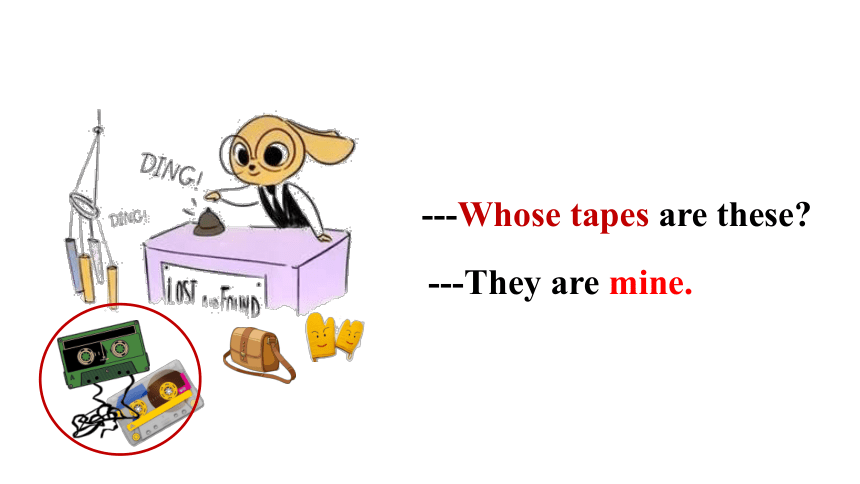

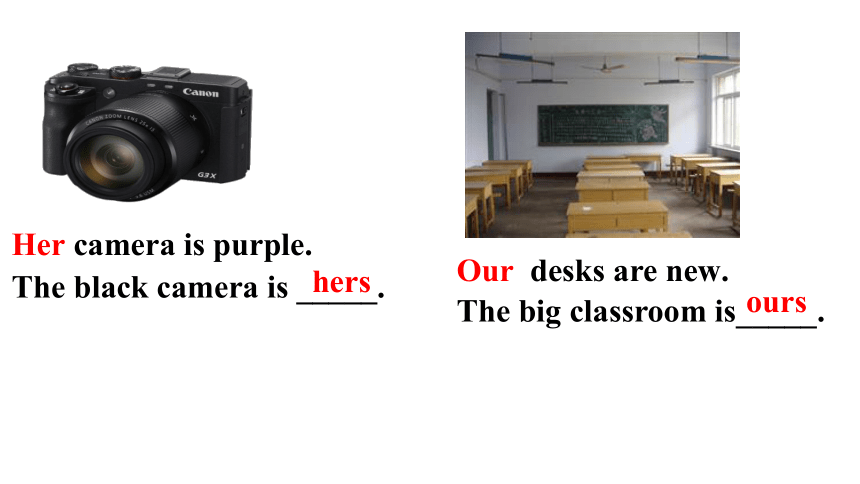

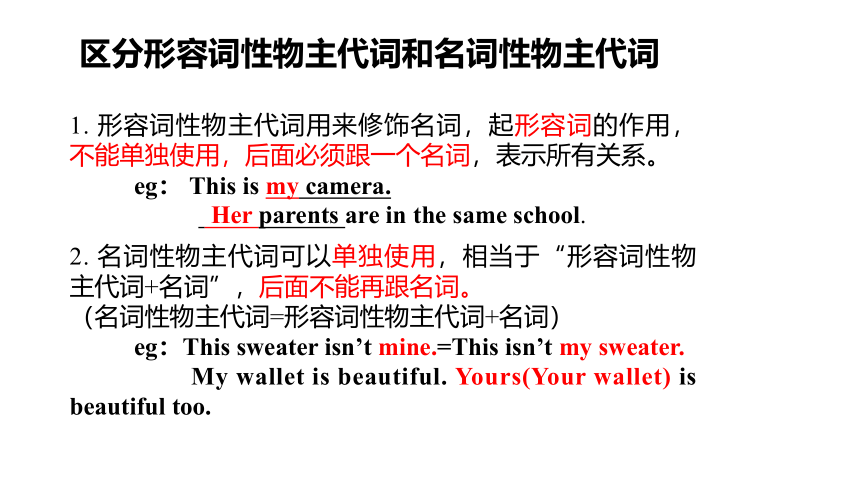
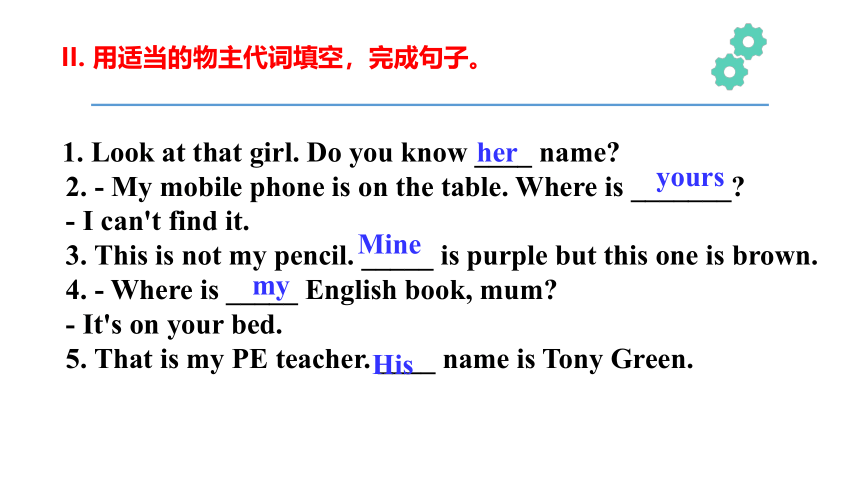
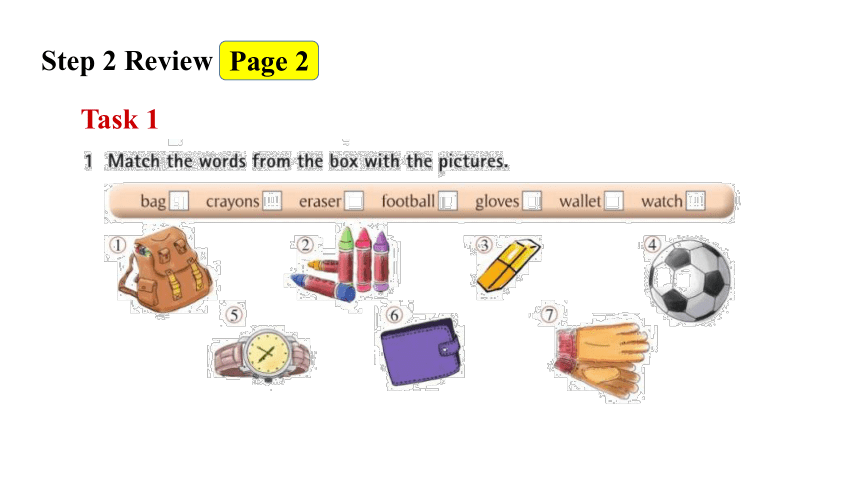
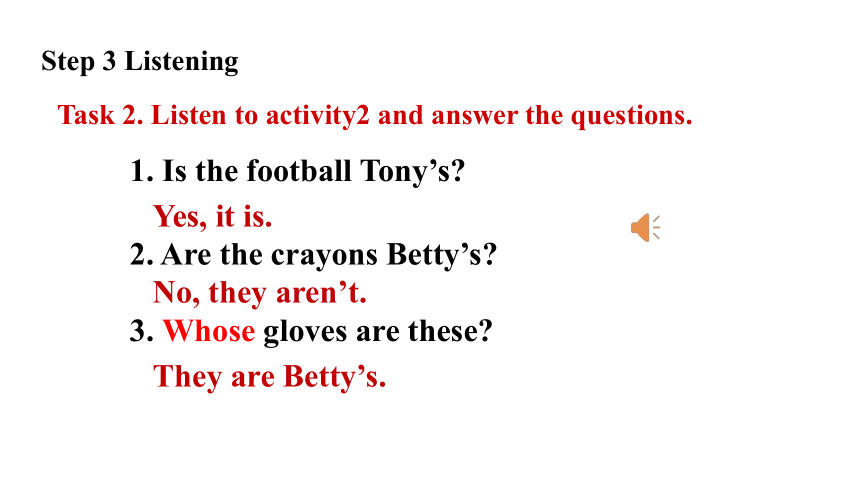

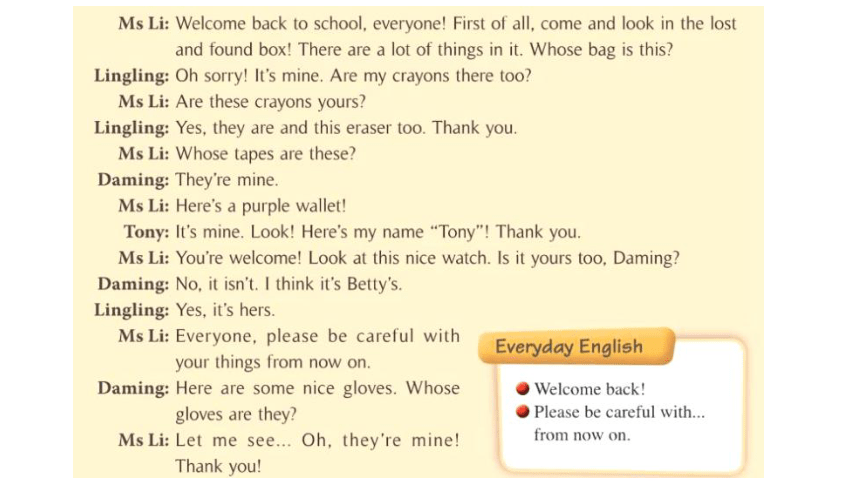
文档简介
(共41张PPT)
Module 1
Lost and found
Unit 1 Whose bag is this
Step 1 Lead in
---Whose bag is this
---It is mine.
= It's my bag
疑问代词,后面通常接名词,用于询问物品的所属关系,作定语。表示“谁的...?”
---Whose tapes are these
---They are mine.
---Whose gloves are these
---They are mine.
Her camera is purple.
The black camera is _____.
hers
Our desks are new.
The big classroom is_____.
ours
形 式 人称 主 格 宾 格 形容词性 物主代词 名词性
物主代词
单数 第一人称 I me my mine
第二人称 you you your yours
第三人称 he she it him her it his her its his
hers
its
复数 第一人称 we us our ours
第二人称 you you your yours
第三人称 they them their theirs
区分形容词性物主代词和名词性物主代词
1. 形容词性物主代词用来修饰名词,起形容词的作用,不能单独使用,后面必须跟一个名词,表示所有关系。
eg: This is my camera.
Her parents are in the same school.
2. 名词性物主代词可以单独使用,相当于“形容词性物主代词+名词”,后面不能再跟名词。
(名词性物主代词=形容词性物主代词+名词)
eg:This sweater isn’t mine.=This isn’t my sweater.
My wallet is beautiful. Yours(Your wallet) is beautiful too.
II. 用适当的物主代词填空,完成句子。
1. Look at that girl. Do you know ____ name
2. - My mobile phone is on the table. Where is _______
- I can't find it.
3. This is not my pencil. _____ is purple but this one is brown.
4. - Where is _____ English book, mum
- It's on your bed.
5. That is my PE teacher. ____ name is Tony Green.
her
yours
Mine
my
His
Step 2 Review
Task 1
Page 2
Task 2. Listen to activity2 and answer the questions.
1. Is the football Tony’s
2. Are the crayons Betty’s
3. Whose gloves are these
Yes, it is.
No, they aren’t.
They are Betty’s.
Step 3 Listening
Step 4 Video
Lingling
Daming
Tony
Ms Li
The bag,crayons and eraser are Lingling's.
The tapes are Daming's.
The purple wallet is Tony's.
The nice watch is Betty's.
The nice gloves are Ms Li's.
crayons
gloves
tapes
wallet
watch
Activity 3: match the people with their things
1 m
首先=at first
失物招领箱
从现在开始
看...
Phrases:
+名词/代词/动名词,“小心...”
be careful to do sth.小心做...
Be careful to go home.
祈使句之Let型:
祈使对象为第一、三人称
let+sb+do sth;
Let us/me/him/Lily have a try;
变否定,don't加句首或not加动词前.
Let him not go=Don't let him go.
whose意为“谁的”,用于询问物品的所属关系,即可用于名词前作定语,也可单独使用作表语,其回答通常为“It's/They're+名代/所有格”
Whose bike is this
---It's mine.
Whose are those books
---They're Lingling's.
名词所有格:
名词+ “'s”构成名词所有格 ,表示所属关系,
可单独使用做表语,如:This book is Lingling's.
也可修饰名词作定语,如:This is Lingling's book.
如果名词为复数,就只加“'”,如:students' homework.
本句是here引导的倒装句,表示“这是,这儿有……”
Here be + 名词。
如: Here are my tapes. 我的磁带在这儿。
Here + 代词 +be. 如: Here they are. 他们在这儿。
正常语序:A purple wallet is here.
language points
LA
1:Welcome back to school, everyone!
Welcome back to+地点:欢迎回到某地。
Welcome sb back to+地点:欢迎某人回到某地
Eg. Teachers welcome students back to school.
Welcome back home.欢迎回家( 地点副词here,there,home不加 to)
Welcome to +地点:欢迎来到某地。
Welcome to school.欢迎来到学校。
language points
LA
2.First of all, come and look in the in the lost and found box(失物招领盒)
first of all 首先,第一 常用于句首,强调首要的事情或动作
Eg. First of all , you should do your homework.
首先,你应当做你的家庭作业。
first of all 侧重于顺序的先后
at first 可位于句首或句末,侧重于时间上的先后
Eg:① First of all, let me tell you a piece of good news.
首先,让我告诉你一则好消息。
②At first, I don’t want to go shopping,but I changed my mind later.
起初,我不想去购物,但是后来我改变了注意。
language points
LA
2.First of all, come and look in the in the lost and found box(失物招领盒)
lose v 丢失,失去------ lost
The girl often loses keys.这个女孩经常弄丢钥匙。
find v 找到,发现 ——— found(强调结果)
I can't find my pen. 我找不到我的钢笔 。
Sentence structures:
01
04
First of all, come and look in the in the lost and found box.
祈使句之V原型:
祈使对象为第二人称you,动词原形开头,主语you一般省略;
Sit down, please.
可加称呼语,用“,”隔开;
Tony, sit down please.
变否定,don't加句首.
Don't sit down.
强调式否定:never+句首
Give up.
Don't give up.
Never give up!
01
04
Let me see......oh , they're mine!
祈使句之Let型:
祈使对象为第一、三人称
let+sb+do sth;
Let us/me/him/Lily have a try.
变否定,not加动词前或don't加句首.
Let him not go=Don't let him go.
language points
There are a lot of things in it. 这里面有许多物品。
a lot of 许多 相当于 lots of 既可以修饰可数名词也可以修饰不可数名词
a lot 十分, 非常 修饰动词,表示程度。相当于very much.
There are __________ people at the airport(机场).
I love the city __________.
a lot of
a lot
01
04
3. Whose bag is this
whose意为“谁的”,用于询问物品的所属关系,即可用于名词前作定语,也可单独使用作表语,
其回答通常为“It‘s/They’re+名词性物主代词/所有格”
Eg. ---Whose bike is this
---It's mine.
Eg. ---Whose books are these
---They're Lingling's.
=Whose is this bike
=Whose are these books
名词所有格:
名词+ “‘s”构成名词所有格 ,表示所属关系 : 表示“…的”
可单独使用做表语,如:This book is Lingling's.
也可修饰名词作定语,如:This is Lingling's book.
如果名词为复数,就只加“'”,如:students' homework.
表示两者共有时,其所有格只在最后那个名词后加“s”
Lingling and Daming's school 玲玲和大明的学校。
表示两者分别分别拥有,两个名词后都要加“s”,且后面跟复数名词
John's and Jane's rooms. (指John和Jane各自的房间。)
正常语序:A purple wallet is here.
本句是here引导的倒装句,表示“这是,这儿有……”
Here +谓语动词 +主语( 名词).
eg: Here are my tapes. 我的磁带在这儿。
Here is your book. 你的书在这里。
Here comes the bus. 公共汽车来了。
Here + 主语(代词)+谓语动词. (主语是代词,句子中的主谓不能倒装)
eg: Here they are. 他们在这儿。
Here it is. 它在这儿。
Here they come. 他们来了。
4.Here's a purple wallet.
language points
Everyone,please be careful with your things from now on.
be careful with 小心对待........后加名词或代词
Be careful with your bike. 小心骑你的自行车。
be careful to do sth 小心做某事
We must be careful to read every word. 我们必须认真读每一个单词
from now on 从现在起.......
Eg. From now on, please choose to be happy!
从现在开始,请选择快乐吧!
Ms Li:
Lingling's bag is in the lost and found box. The crayons are_______ too. Daming's________and Tony's ________wallet are here. Is the watch _______, Daming Please be__________with your things! And whose gloves are these Oh, sorry. They're _______.
hers
tapes
purple
yours
Step 3 Practice
careful
mine
careful hers mine purple tape yours
Homework
Module 1
Lost and found
Unit 1 Whose bag is this
Step 1 Lead in
---Whose bag is this
---It is mine.
= It's my bag
疑问代词,后面通常接名词,用于询问物品的所属关系,作定语。表示“谁的...?”
---Whose tapes are these
---They are mine.
---Whose gloves are these
---They are mine.
Her camera is purple.
The black camera is _____.
hers
Our desks are new.
The big classroom is_____.
ours
形 式 人称 主 格 宾 格 形容词性 物主代词 名词性
物主代词
单数 第一人称 I me my mine
第二人称 you you your yours
第三人称 he she it him her it his her its his
hers
its
复数 第一人称 we us our ours
第二人称 you you your yours
第三人称 they them their theirs
区分形容词性物主代词和名词性物主代词
1. 形容词性物主代词用来修饰名词,起形容词的作用,不能单独使用,后面必须跟一个名词,表示所有关系。
eg: This is my camera.
Her parents are in the same school.
2. 名词性物主代词可以单独使用,相当于“形容词性物主代词+名词”,后面不能再跟名词。
(名词性物主代词=形容词性物主代词+名词)
eg:This sweater isn’t mine.=This isn’t my sweater.
My wallet is beautiful. Yours(Your wallet) is beautiful too.
II. 用适当的物主代词填空,完成句子。
1. Look at that girl. Do you know ____ name
2. - My mobile phone is on the table. Where is _______
- I can't find it.
3. This is not my pencil. _____ is purple but this one is brown.
4. - Where is _____ English book, mum
- It's on your bed.
5. That is my PE teacher. ____ name is Tony Green.
her
yours
Mine
my
His
Step 2 Review
Task 1
Page 2
Task 2. Listen to activity2 and answer the questions.
1. Is the football Tony’s
2. Are the crayons Betty’s
3. Whose gloves are these
Yes, it is.
No, they aren’t.
They are Betty’s.
Step 3 Listening
Step 4 Video
Lingling
Daming
Tony
Ms Li
The bag,crayons and eraser are Lingling's.
The tapes are Daming's.
The purple wallet is Tony's.
The nice watch is Betty's.
The nice gloves are Ms Li's.
crayons
gloves
tapes
wallet
watch
Activity 3: match the people with their things
1 m
首先=at first
失物招领箱
从现在开始
看...
Phrases:
+名词/代词/动名词,“小心...”
be careful to do sth.小心做...
Be careful to go home.
祈使句之Let型:
祈使对象为第一、三人称
let+sb+do sth;
Let us/me/him/Lily have a try;
变否定,don't加句首或not加动词前.
Let him not go=Don't let him go.
whose意为“谁的”,用于询问物品的所属关系,即可用于名词前作定语,也可单独使用作表语,其回答通常为“It's/They're+名代/所有格”
Whose bike is this
---It's mine.
Whose are those books
---They're Lingling's.
名词所有格:
名词+ “'s”构成名词所有格 ,表示所属关系,
可单独使用做表语,如:This book is Lingling's.
也可修饰名词作定语,如:This is Lingling's book.
如果名词为复数,就只加“'”,如:students' homework.
本句是here引导的倒装句,表示“这是,这儿有……”
Here be + 名词。
如: Here are my tapes. 我的磁带在这儿。
Here + 代词 +be. 如: Here they are. 他们在这儿。
正常语序:A purple wallet is here.
language points
LA
1:Welcome back to school, everyone!
Welcome back to+地点:欢迎回到某地。
Welcome sb back to+地点:欢迎某人回到某地
Eg. Teachers welcome students back to school.
Welcome back home.欢迎回家( 地点副词here,there,home不加 to)
Welcome to +地点:欢迎来到某地。
Welcome to school.欢迎来到学校。
language points
LA
2.First of all, come and look in the in the lost and found box(失物招领盒)
first of all 首先,第一 常用于句首,强调首要的事情或动作
Eg. First of all , you should do your homework.
首先,你应当做你的家庭作业。
first of all 侧重于顺序的先后
at first 可位于句首或句末,侧重于时间上的先后
Eg:① First of all, let me tell you a piece of good news.
首先,让我告诉你一则好消息。
②At first, I don’t want to go shopping,but I changed my mind later.
起初,我不想去购物,但是后来我改变了注意。
language points
LA
2.First of all, come and look in the in the lost and found box(失物招领盒)
lose v 丢失,失去------ lost
The girl often loses keys.这个女孩经常弄丢钥匙。
find v 找到,发现 ——— found(强调结果)
I can't find my pen. 我找不到我的钢笔 。
Sentence structures:
01
04
First of all, come and look in the in the lost and found box.
祈使句之V原型:
祈使对象为第二人称you,动词原形开头,主语you一般省略;
Sit down, please.
可加称呼语,用“,”隔开;
Tony, sit down please.
变否定,don't加句首.
Don't sit down.
强调式否定:never+句首
Give up.
Don't give up.
Never give up!
01
04
Let me see......oh , they're mine!
祈使句之Let型:
祈使对象为第一、三人称
let+sb+do sth;
Let us/me/him/Lily have a try.
变否定,not加动词前或don't加句首.
Let him not go=Don't let him go.
language points
There are a lot of things in it. 这里面有许多物品。
a lot of 许多 相当于 lots of 既可以修饰可数名词也可以修饰不可数名词
a lot 十分, 非常 修饰动词,表示程度。相当于very much.
There are __________ people at the airport(机场).
I love the city __________.
a lot of
a lot
01
04
3. Whose bag is this
whose意为“谁的”,用于询问物品的所属关系,即可用于名词前作定语,也可单独使用作表语,
其回答通常为“It‘s/They’re+名词性物主代词/所有格”
Eg. ---Whose bike is this
---It's mine.
Eg. ---Whose books are these
---They're Lingling's.
=Whose is this bike
=Whose are these books
名词所有格:
名词+ “‘s”构成名词所有格 ,表示所属关系 : 表示“…的”
可单独使用做表语,如:This book is Lingling's.
也可修饰名词作定语,如:This is Lingling's book.
如果名词为复数,就只加“'”,如:students' homework.
表示两者共有时,其所有格只在最后那个名词后加“s”
Lingling and Daming's school 玲玲和大明的学校。
表示两者分别分别拥有,两个名词后都要加“s”,且后面跟复数名词
John's and Jane's rooms. (指John和Jane各自的房间。)
正常语序:A purple wallet is here.
本句是here引导的倒装句,表示“这是,这儿有……”
Here +谓语动词 +主语( 名词).
eg: Here are my tapes. 我的磁带在这儿。
Here is your book. 你的书在这里。
Here comes the bus. 公共汽车来了。
Here + 主语(代词)+谓语动词. (主语是代词,句子中的主谓不能倒装)
eg: Here they are. 他们在这儿。
Here it is. 它在这儿。
Here they come. 他们来了。
4.Here's a purple wallet.
language points
Everyone,please be careful with your things from now on.
be careful with 小心对待........后加名词或代词
Be careful with your bike. 小心骑你的自行车。
be careful to do sth 小心做某事
We must be careful to read every word. 我们必须认真读每一个单词
from now on 从现在起.......
Eg. From now on, please choose to be happy!
从现在开始,请选择快乐吧!
Ms Li:
Lingling's bag is in the lost and found box. The crayons are_______ too. Daming's________and Tony's ________wallet are here. Is the watch _______, Daming Please be__________with your things! And whose gloves are these Oh, sorry. They're _______.
hers
tapes
purple
yours
Step 3 Practice
careful
mine
careful hers mine purple tape yours
Homework
同课章节目录
- Module 1 Lost and found
- Unit 1 Whose bag is this?
- Unit 2 Are they yours?
- Unit 3 Language in use
- Module 2 What can you do ?
- Unit 1 I can play the piano
- Unit 2 I can run really fast
- Unit 3 Language in use
- Module 3 Making plans
- Unit 1 What are you going to do at the weekends?
- Unit 2 We're going to cheer the players.
- Unit 3 Language in use
- Module 4 Life in the future
- Unit 1 Everyone will study at home
- Unit 2 Every family will have a small plane.
- Unit 3 Language in use
- Module 5 Shopping
- Unit 1 What can I do for you?
- Unit 2 You can buy everything on the Internet
- Unit 3 Language in use
- Module 6 Around town
- Unit 1 Could you tell me how to get to the Nationa
- Unit 2 The London Eye is on your right.
- Unit 3 Language in use
- Revision module A
- Module 7 My past life
- Unit 1 I was born in a small village.
- Unit 2 I was born in Quincy.
- Unit 3 Language in use
- Module 8 Story time
- Unit 1 Once upon a time….
- Unit 2 Goldilocks hurried out of the house.
- Unit 3 Language in use
- Module 9 Life history
- Unit 1 He left school and began work at the age of
- Unit 2 He decided to be an actor.
- Unit 3 Language in use
- Module 10 A holiday journey
- Unit 1 What did you do?
- Unit 2 This morning we took a walk.
- Unit 3 Language in use
- Module 11 Body language
- Unit 1 They touch noses!
- Unit 2 Here are some ways to welcome them.
- Unit 3 Language in use
- Module 12 Western music
- Unit 1 It's so beautiful!
- Unit 2 Vienna is the centre of European classical
- Unit 3 Language in use
- Revision module B
